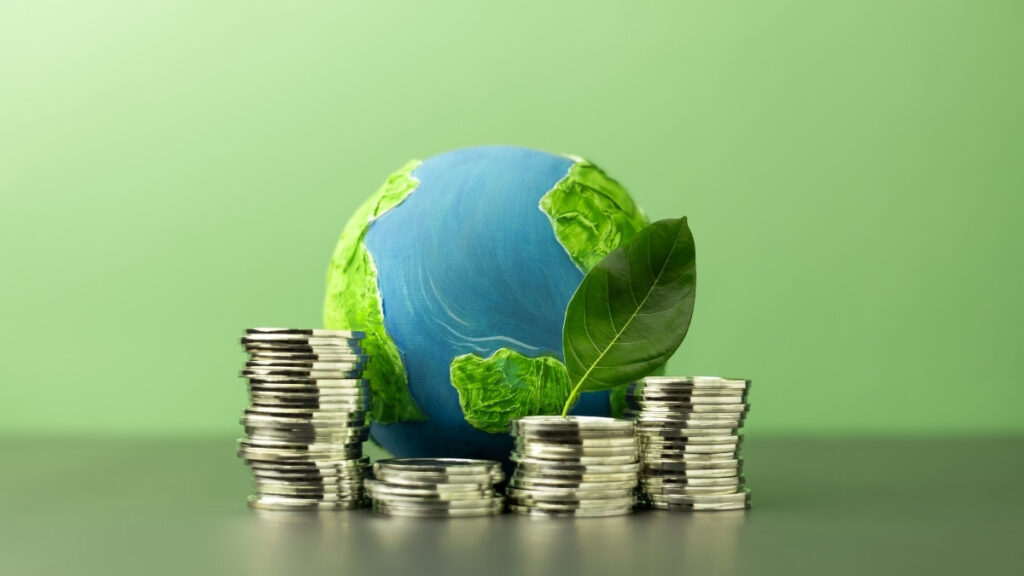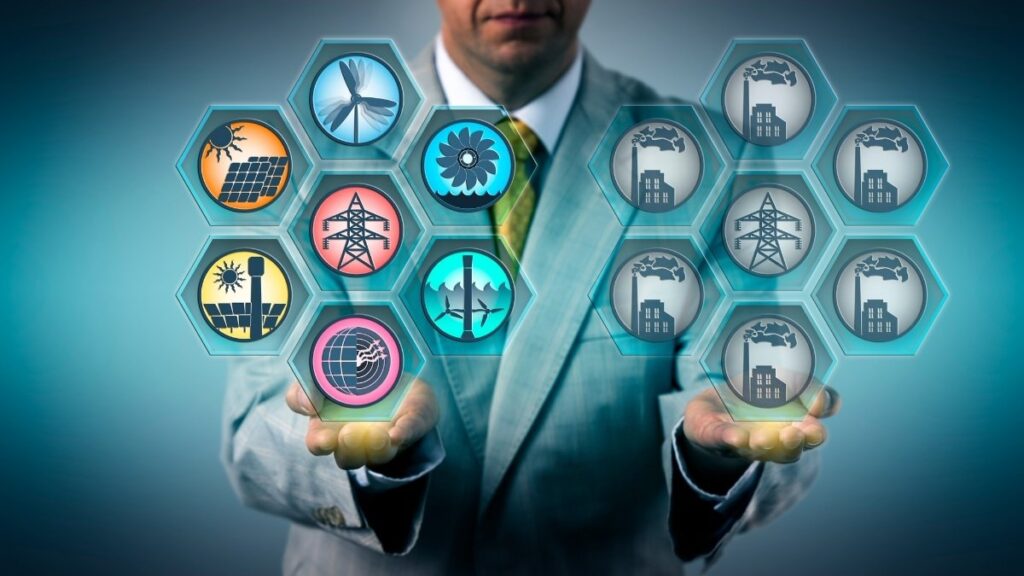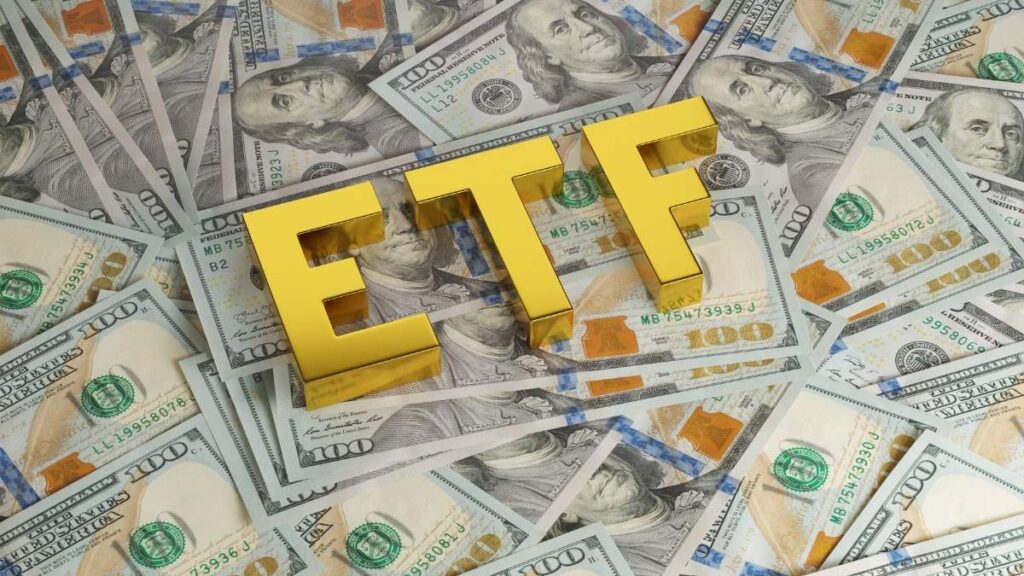In a year where headlines screamed about ESG backlash and sustainable fund outflows, a corner of Jason’s portfolio quietly delivered his best returns. That corner was labeled ‘Climate Change,’ but his strategy had nothing to do with the generic ‘green’ funds that stumbled.
Like many investors, Jason was interested in aligning his portfolio with the global energy transition, but he was also deeply confused by the conflicting news.
On one hand, there were stories of a massive, multi-trillion-dollar long-term opportunity. On the other, there were sobering reports of poor recent performance, political headwinds, and widespread investor skepticism. It felt like navigating a minefield.
The Irreversible Transition: Why Climate Investing Hit an Inflection Point in 2025
To understand the success of my climate-focused investments, it’s essential to first grasp the fundamental economic and technological shifts that are reshaping the global economy.
This isn’t about wishful thinking; it’s about following the capital, the data, and the undeniable momentum of a worldwide industrial transformation. The story begins by confronting the very real concerns that have made many investors hesitant.
Deconstructing the “Performance Paradox”

The biggest hurdle for many investors considering this space is the “performance paradox”: the stark contrast between the long-term promise and the recent, often disappointing, returns of many sustainable funds. The data from 2023 and 2024 is clear: US sustainable funds faced significant headwinds, suffering their second consecutive year of outflows, which reached $19.6 billion in 2024.
Performance lagged conventional peers, with only 42% of sustainable funds landing in the top half of their respective Morningstar Categories. Sustainable equity funds, in particular, struggled; their median return of 20.7% in 2024 was lower than the 21.5% for conventional funds and well below the 24.1% gain of the Morningstar US Market Index.
This underperformance was driven by factors like high interest rates negatively impacting the growth and tech stocks often held in these funds, coupled with a potent political backlash against ESG investing.
The Data-Backed Link: ESG & Financial Performance
The outperformance of well-structured climate funds is not an anomaly; it is grounded in a vast body of academic and financial research demonstrating a positive correlation between strong sustainability practices and corporate financial health.
A landmark meta-analysis from the NYU Stern Center for Sustainable Business reviewed over 1,000 studies published between 2015 and 2020 and found compelling evidence of this link.
The review concluded that 58% of corporate studies showed a positive relationship between ESG and financial metrics like Return on Equity ($ROE$) and Return on Assets ($ROA$), while only 8% showed a negative relationship.
The 2025 Tipping Point: Renewables Officially Surpass Coal

A major historical milestone is occurring in 2025 that cements the investment case for the energy transition.
According to extensive analysis by the London Stock Exchange Group (LSEG), renewables are expected to surpass coal as the largest source of global electricity production this year.
This is not a future projection but a present-day reality, marking a fundamental and permanent shift in the world’s energy mix.
This tipping point is the result of exponential growth and powerful economic drivers. The installation of solar photovoltaics (PV) grew by an astonishing 36% between the first half of 2023 and the first half of 2024, while electric vehicle (EV) sales jumped 25% over the same period.
This explosive growth is underpinned by a crucial economic advantage: the dramatic and sustained fall in the prices of key green energy equipment. After a brief rise in 2022, the costs of solar panels and EV batteries resumed their steep decline in 2023 and 2024, driven by massive increases in manufacturing capacity.
The AI Catalyst: An Unexpected Demand Shock for Clean Energy

One of the most powerful, and least obvious, tailwinds for clean energy investment in 2025 comes from an entirely different technological revolution: Artificial Intelligence.
The AI boom is proving to be a “double-edged sword” for the climate transition. While AI can be used to optimize energy grids and model climate risks, its massive computing power creates an unprecedented and rapidly growing demand for electricity.
This demand originates in data centers, the “mission critical” digital infrastructure powering AI, which is now one of the fastest-growing sectors of the economy.
Analysts expect that the power demand from data centers will “grow significantly” in the coming years, to the point where it is “increasingly cited as a driver in new energy policies”.
The crucial link for investors is that the primary customers for this new AI infrastructure—tech giants like Microsoft, Google, and Amazon—have some of the most ambitious corporate net-zero goals in the world.
They cannot power this explosive new growth with fossil fuels without completely derailing their climate commitments and facing immense pressure from their investors and customers.
The Next Frontier: Investing in Climate Adaptation and Resilience

While much of the focus has been on climate mitigation—investing in technologies like solar and wind to reduce emissions—a sophisticated and increasingly urgent investment theme is emerging: climate adaptation.
As global emissions continue to rise, the world is now on track to breach the 1.5-degree Celsius warming threshold targeted by the Paris Agreement. This makes the physical impacts of climate change—such as extreme weather events, rising sea levels, and water scarcity—inevitable.
The financial implications are staggering. In 2024 alone, the estimated cost of weather and climate disasters in the United States was $182 billion. This reality is forcing a shift in focus among forward-thinking investors and policymakers.
As experts from the University of Cambridge’s Institute for Sustainable Leadership (CISL) note, “too often, the focus remains on mitigation with the physical risks either overlooked or underestimated”. This is changing rapidly in 2025.
This shift creates a new, non-discretionary spending category for governments and corporations, opening up a vast investment universe centered on building resilience. This includes opportunities in areas such as:
Resilient Infrastructure: Upgrading electricity grids, transportation networks, and buildings to withstand extreme weather.
Water Management: Technologies for water purification, conservation, and efficient irrigation.
Climate-Smart Agriculture: Developing drought-resistant crops and more efficient farming techniques.
Early Warning Systems: Advanced weather modeling and disaster-response technologies.
The economic case is compelling. The UN Principles for Responsible Investment (PRI) estimates that a $1.8 trillion investment in key adaptation measures before 2030 could generate $7.1 trillion in net benefits for the global economy.
For investors, this represents a pragmatic, less-crowded, and potentially highly profitable frontier that complements investments in renewable energy generation.
Your 2025 Climate Investing Toolkit: From Broad ETFs to Direct Project Ownership

Understanding the “why” behind climate investing is the first step. The next is knowing “how.”
The modern investment landscape offers a diverse toolkit for gaining exposure to the energy transition, with options suited to every level of risk tolerance and capital.
Here is a breakdown of the primary vehicles, ordered from the most accessible to the most direct.
The Foundation: Thematic & Clean Energy ETFs
Power Up Your Portfolio!
Top Clean Energy ETFs to Watch in 2025
Invesco WilderHill Clean Energy ETF
Tracks US companies in cleaner energy & conservation.
iShares Global Clean Energy ETF
Global exposure to leading clean energy companies.
Invesco Solar ETF
Concentrated bet on the global solar energy industry.
First Trust Global Wind Energy ETF
Global exposure to companies active in the wind energy sector.
Global X Lithium & Battery Tech ETF
“Picks and shovels” play on EVs and energy storage (lithium cycle).
SPDR S&P Kensho Clean Power ETF
Tracks innovative companies in clean power generation & technology.
For most retail investors, Exchange-Traded Funds (ETFs) are the simplest and most effective entry point. These funds hold a basket of dozens or even hundreds of companies involved in the climate theme, offering instant diversification and liquidity.
However, as the performance paradox of 2024 showed, not all “green” ETFs are created equal. The key in 2025 is to look beyond generic ESG labels and choose funds with a clear, thematic focus on the technologies and infrastructure of the energy transition.
This means differentiating between various sub-themes:
Broad Clean Energy: Funds like the iShares Global Clean Energy ETF (ICLN) provide global exposure to a wide range of companies, from utilities to equipment manufacturers.
Specific Technologies: For a more concentrated bet, investors can choose ETFs that focus on a single technology, such as the Invesco Solar ETF (TAN) for solar power or the First Trust Global Wind Energy ETF (FAN) for wind.
Enabling Technologies: A “picks and shovels” approach involves investing in the components that make the transition possible. The Global X Lithium & Battery Tech ETF (LIT), for example, focuses on the booming demand for batteries essential for EVs and grid storage.
When evaluating these funds, it is critical to look past the name and examine the underlying index methodology—such as the WilderHill Clean Energy Index (ECO) or the NASDAQ Clean Edge Green Energy Index (CELS)—as well as the top holdings and the expense ratio.
The High-Conviction Approach: Investing in Individual Climate Tech Stocks

For investors with a higher risk tolerance and a willingness to conduct deeper research, investing in individual companies offers the potential for greater returns. This approach requires a clear understanding of the different segments of the energy value chain, which can be broken down into three main categories :
Upstream: Companies involved in technology development, exploration, and manufacturing. This includes pure-play technology leaders like solar panel manufacturer First Solar or residential solar tech provider Enphase Energy.
These stocks often carry higher risk and return potential due to their sensitivity to technological shifts and competition.
Midstream: Companies that own and operate the infrastructure of the energy transition, such as electricity grids and storage facilities.
Downstream/Integrated: Large, established utility companies that are aggressively shifting their generation portfolios to renewables.
A prime example is NextEra Energy, one of the world’s largest generators of wind and solar power. These companies often offer more stability and dividends compared to pure-play tech stocks.
When selecting individual stocks, it is crucial to analyze not only their technology and market position but also their financial health and valuation. While some high-profile names like Tesla can be volatile and expensive, many established players like NextEra Energy offer a more affordable entry point.
Following the investments of major institutional developers like The AES Corporation and NextEra Energy Partners can also provide clues as to where “big money” sees long-term value.
The Direct Impact Investor: Crowdfunding and Private Project Ownership

One of the most innovative and compelling ways to invest in the climate transition is through platforms that allow individuals to invest directly in renewable energy projects.
This model represents a significant shift in the investment landscape, leveraging technology and new regulations like the SEC’s Regulation A+ to give retail investors access to private infrastructure assets that were once the exclusive domain of institutional capital.
Platforms like Energea, Climatize, and Energy Shares allow investors to bypass traditional funds and own a piece of a specific solar farm, battery storage facility, or other clean energy asset. Using Energea as a case study, the model works as follows:
The Investment: Investors purchase shares in a fund that owns and operates a portfolio of specific, tangible renewable energy projects, such as community solar installations in Brazil or commercial rooftop solar in South Africa.
The Benefits: This approach offers several unique advantages. First, the potential for high-yield, inflation-protected returns; Energea, for example, reports a realized internal rate of return (IRR) of 12.11% for its investors to date. Second, many platforms offer regular income in the form of monthly cash dividends.
Third, it provides a direct, verifiable impact, as investors know exactly which projects their capital is funding, offering a powerful solution to the greenwashing concerns that plague public markets.
The Process & Risks: Getting started is typically straightforward, involving creating an account on the platform and investing with a low minimum, sometimes as little as $100. However, investors must understand the risks. These are private, illiquid investments, often with multi-year holding periods.
This direct investment model offers a powerful combination of potential financial return and tangible impact, making it an increasingly popular choice for sophisticated investors.
Due Diligence in a Polarized World: Navigating Greenwashing & Political Risk

Investing successfully in the climate transition requires more than just picking the right assets; it demands a clear-eyed approach to managing the unique risks of this sector.
In 2025, two challenges stand out: the persistent threat of “greenwashing” and the uncertainty of a polarized political and regulatory environment. Building credibility as an investor means honestly addressing these issues and developing a robust framework for due diligence.
The Greenwashing Playbook: A 2025 Investor’s Guide to Spotting Deception

“Greenwashing”—the practice of making misleading claims about the environmental benefits of an investment—remains a significant hurdle.
The lack of universal, legally binding definitions for terms like “green,” “sustainable,” or “ESG” creates loopholes that some fund managers and companies exploit.
Investor skepticism is warranted; a PwC survey found that a staggering 87% of investors believe that corporate sustainability reporting contains some level of greenwashing.
To navigate this, investors need to move beyond marketing materials and adopt a forensic approach.
Here is an actionable playbook for spotting and avoiding deception:
Look Past the Label: Ignore fund names that include words like “ESG,” “Sustainable,” or “Green.” These terms are often meaningless. The real story is in the fund’s official documents and holdings.
Scrutinize the Top 10 Holdings: Go directly to the fund’s prospectus or website and examine the top holdings. Do they align with the fund’s stated purpose?
A “clean energy” fund heavily invested in utilities that still operate significant fossil fuel assets may not be what it seems. This is critical, as investigations have found supposedly “Dark Green” funds with significant investments in fossil fuels and aviation.
Use Third-Party Tools: Leverage independent rating agencies to get an objective view. Resources like Morningstar Sustainalytics’ ESG Risk Ratings provide a detailed, multi-dimensional assessment of a company’s exposure to material ESG risks and how well it is managing them, cutting through corporate spin.
Demand Specificity: Be skeptical of vague language. A fund that merely “considers” ESG factors is very different from one with a binding mandate to invest a specific percentage of its assets in defined climate solutions.
True impact and thematic purity come from clear, measurable objectives, not loose guidelines.
The 2025 Political & Regulatory Chessboard
The political landscape in 2025 is undeniably complex and polarized, creating significant perceived risk for investors.
In the United States, a new administration signals potential shifts in energy and environmental policy, while globally, views on ESG standards are diverging.
This has led to concerns about the durability of regulations that support the energy transition.
Building Your Climate-Focused Portfolio: An Actionable 5-Step Framework
With a clear understanding of the opportunities, vehicles, and risks, the final step is to translate this knowledge into a practical investment plan. This five-step framework provides a structured approach to building a climate-focused allocation within a broader portfolio.
Step 1: Define Your “Why” and Set Objectives. Before investing a single dollar, clarify your primary motivation. Are you seeking to generate alpha and add a diversifying growth engine to your portfolio?
This aligns with the 77% of North American institutional investors whose top reasons for investing in the energy transition are diversification and alpha generation.
Step 2: Choose Your Vehicle(s) – The Core-Satellite Approach. A prudent way to structure your allocation is the “core-satellite” model.
The Core: This should be a well-diversified, low-cost foundational position. A broad global clean energy ETF, such as ICLN, could serve as an excellent core, providing exposure to dozens of leading companies across the entire value chain.
The Satellites: These are smaller, higher-conviction positions designed to target specific high-growth areas or objectives.
Your satellites could include a concentrated solar ETF like TAN, a few carefully selected individual stocks in areas like battery technology or grid infrastructure, or a small allocation to a direct investment platform like Energea to add yield and direct impact.
Step 3: Conduct Deep Due Diligence. This is where you apply the rigorous anti-greenwashing playbook from the previous section. Do not rely on marketing materials.
For any ETF you consider, download the full list of holdings and review the prospectus. For individual stocks, read their latest annual report and investor presentations, paying close attention to their stated climate strategy and capital expenditure plans.
For direct investment platforms, it is imperative to read the full SEC Offering Circular, which details the specific projects, fee structure, and risks involved.
Step 4: Allocate and Invest. Determine a sensible allocation size. For a thematic investment like this, starting with an allocation of 5-10% of your total investment portfolio is a common strategy.
This provides meaningful exposure without taking on excessive concentration risk. To mitigate the impact of market volatility, especially in historically volatile thematic ETFs, consider using a dollar-cost averaging strategy—investing a fixed amount of money at regular intervals—rather than investing a single lump sum.
Step 5: Monitor and Re-evaluate. A climate-focused portfolio is not a “set and forget” investment. The technology, regulatory landscape, and market dynamics are evolving rapidly. Plan to review your holdings at least quarterly.
Monitor not just the financial performance but also the underlying trends discussed in this article. Is the impact of AI on energy demand accelerating? Are new investment opportunities in climate adaptation and resilience becoming more accessible?
Be prepared to rebalance your portfolio—trimming positions that have become oversized or adding to areas with emerging potential—as the market evolves.
Investing in a Livable Planet and a Profitable Future

The narrative around climate investing has fundamentally shifted in 2025. The era of vague promises and the underperformance of broad ESG funds is giving way to the tangible outperformance of targeted, strategic investments in the machinery of the global energy transition.
We have moved from an abstract concept to a concrete, multi-trillion-dollar industrial transformation, one driven by unstoppable economic forces like the falling cost of technology and the exponential rise of new energy demands from AI and electrification.
The opportunity is no longer just on the horizon; it’s here. The toolkit is more diverse and accessible than ever, from specialized ETFs that capture the growth of solar and wind to innovative platforms that allow you to own a direct stake in a renewable energy project.
By moving beyond generic labels and investing with a clear-eyed, data-driven strategy, you can position your portfolio to capitalize on one of the greatest economic transformations of our lifetime.
Start your research today. Look under the hood of that clean energy ETF. Explore the new world of direct project investment. The future is being built now—you can own a piece of it.

